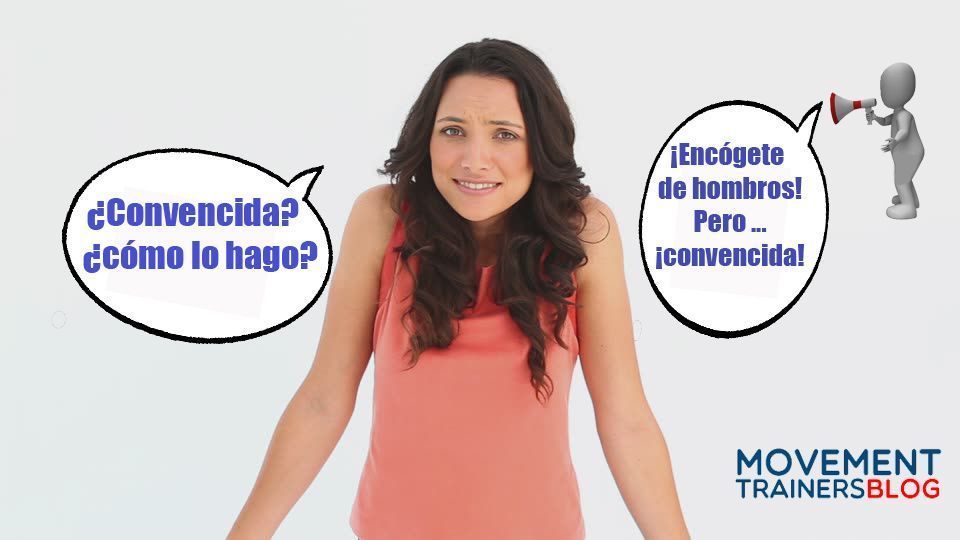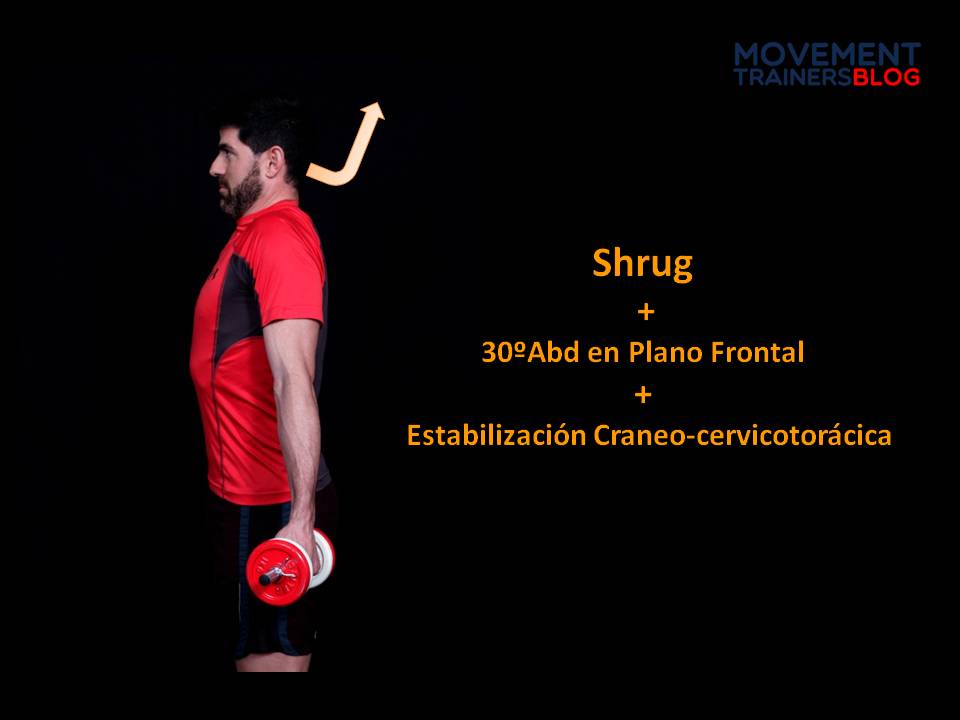[vc_row][vc_column][vc_column_text]

¡ENCÓGETE DE HOMBROS!, PERO HAZLO CONVENCIDO
Encogerse de hombros se dice shrug en inglés, y puede ser un ejercicio, pero también hace referencia a un gesto que utilizamos para mostrar duda, cuando no estamos seguros o convencidos. Resulta que el «shrug» puede ser un ejercicio fundamental para algunas personas, mientras que para otras puede ser perjudicial; y aunque esto pasa con multitud de ejercicios, en algunos es clave saber determinar para quién está indicado. Pero vamos a empezar por ver cómo se hace un Shrug optimizando la participación del trapecio superior y el movimiento aislado de la rotación superior escapular.
Así en esta entrada hemos tratado de responder a dos preguntas: Cómo se hace un Shrug, y para quienes está indicado.
En respuesta al Cómo:
El Shrug tradicional2,11 se realiza con mancuernas y los brazos pegados al tronco, elevando los hombros.
Shrug + 30ºAbd22,28,29. Genera mayor actividad del trapecio superior, serrato anterior y trapecio inferior. Lo cual se ha hipotetizado que puede deberse a una optimización de la curva longitud-tensión muscular. La abducción produce mayores niveles de activación del trapecio superior que la flexión1, debido al mayor brazo de momento12. En personas con impingement subacromial podríamos incluso usal una toalla u otro elemento para generar esa abducción:
Shrug + 30ºAbd + Plano Frontal15. Este ejercicio mostró mayor actividad del trapecio superior que los anteriores, y también mayor ratio TrapS/TrapI. Lo cual se debe a que el plano frontal coincide con las líneas de tracción del trapecio superior. Y también, aunque con una diferencia no significativa, el nivel más bajo de activación del elevador de la escápula.
 Shrug + 30ºAbd + Plano Frontal + Estabilización Craneo-cervicotorácica15. Se alcanzan niveles más altos de rotación superior escapular. Aunque el grado de activación del trapecio superior sea similar, el resultado se ve aumentado debido a la estabilización de la musculatura profunda del cuello, que provee de una base estable. Aunque no de forma significativa, este ejercicio aumentó la actividad de trapecio inferior, el serrato anterior y el elevador de la escápula.
Shrug + 30ºAbd + Plano Frontal + Estabilización Craneo-cervicotorácica15. Se alcanzan niveles más altos de rotación superior escapular. Aunque el grado de activación del trapecio superior sea similar, el resultado se ve aumentado debido a la estabilización de la musculatura profunda del cuello, que provee de una base estable. Aunque no de forma significativa, este ejercicio aumentó la actividad de trapecio inferior, el serrato anterior y el elevador de la escápula.
Pero estas indicaciones están dirigidas a optimizar un ejercicio eminentemente analítico. Somos más partidarios de convertir estas tareas en juegos:
En respuesta a Para Quién:
El trapecio es un músculo clave en la movilidad escapular, siendo el máximo responsable de la rotación superior20,27. Pero hoy en día nos encontramos con mucha frecuencia personas con un trapecio superior en tensión debido a que estamos solicitando esta musculatura de forma continua, de hecho para mucha gente es uno de los “imputados del hombro”, se trata de un músculo que se ha ganado mala fama.
PERO NO TODO EL MUNDO TIENE UN TRAPECIO SUPERIOR EN TENSIÓN, ACORTADO, ……. De hecho hay personas que tienen un trapecio superior débil, elongado… y son esas personas las que tienen indicado este ejercicio.
El desequilibrio muscular entre un Trapecio superior elongado y un elevador de la escápula acortado puede producir un tipo de disquinesia llamada Síndome de Rotación Inferior Escapular, caracterizada por una escápula caída y una incrementada rotación inferior23. Para saber determinar cuando una escápula está en rotación inferior, ver: ITV Escapular: Movilidad. El foco de la recuperación funcional de este síndrome se basa en el fortalecimiento del trapecio superior, para lo que el ejercicio más utilizado es el “Shrug”2,11 y también serán interesantes ejercicios de estiramientos del angular del omóplato.
En Personas con este síndrome, aunque el trabajo se focalice sobre la activación del Trapecio superior, va a ser también muy importante el trabajo postural, ya que la rotación superior escapular se ve reducida en personas con la cabeza adelantada17,30 y con cifosis8,13.
Por ejemplo te planteamos un juego para trabajar con personas con cifosis, cabeza adelantada que presentan alteraciones funcionales o dolor.
Esperamos que tras esta entrada los entrenadores sepan corregir perfectamente un Shrug. Pero sobre todo esperamos que sepan cuando hay que prescribir a un cliente/deportista este ejercicio, y puedan decirle, con seguridad, que por una vez en su vida se encojan de hombros convencidos.
BIBLIOGRAFÍA:
-
Antony, N. T., & Keir, P. J. (2010). Effects of posture, movement and hand load on shoulder muscle activity. Journal of Electromyography and Kinesiology, 20, 191–198.
-
Burkhead, W. Z., Jr., & Rockwood, C. A. Jr., (1992). Treatment of instability of the shoulder with an exercise program. Journal of Bone and Joint Surgery, 74, 890–896.
-
Cools, A.M., et al., Evaluation of isokinetic force production and associated muscle activity in the scapular rotators during a protraction-retraction movement in overhead athletes with impingement symptoms. Br J Sports Med. 2004;38(1):64–68.
-
Cools, A.M., et al., Scapular muscle recruitment pattern: electromyographic response of the trapezius muscle to sudden shoulder movement before and after a fatiguing exercise. J Orthop Sports Phys Ther. 2002;32(5):221–229.
-
Cools, A.M., et al., Scapular muscle recruitment patterns: trapezius muscle latency with and without impingement symptoms. Am J Sports Med. 2003;31(4):542–549.
-
Cools, A.M., et al., Trapezius activity and intramuscular balance during isokinetic exercise in overhead athletes with impingement symptoms. Scand J Med Sci Sports. 2007;17(1):25–33.
-
DePalma, M. J., & Johnson, E. W. (2003). Detecting and treating shoulder impingement syndrome: the role of scapulothoracic dyskinesis. The Physician and Sportsmedicine, 31(7), 25–32
-
Finley, M. A., & Lee, R. Y. (2003). Effect of sitting posture on 3-dimensional scapular kinematics measured by skin-mounted electromagnetic tracking sensors. Archives of Physical Medicine and Rehabilitation, 84, 563–568.
-
Hagen K, Einarsen C, Zwart JA, Svebak S, Bovim G. The cooccurrence of headache and musculoskeletal symptoms amongst 51050 adults in Norway. Eur J Neurol. 2002;9:527–33.
-
Haldeman S, Dagenais S. Cervicogenic headaches: a critical review. Spine J. 2001;1:31–46.
-
Hintermeister, R. A., Lange, G. W., Schultheis, J. M., Bey, M. J., & Hawkins, R. J. (1998). Electromyographic activity and applied load during shoulder rehabilitation exercises using elastic resistance. The American Journal of Sports Medicine, 26, 210–220.
-
Hughes, R. E., & An, K. N. (1996). Force analysis of rotator cuff muscles. Clinical Orthopaedics and Related Research, 330, 75–83.
-
Kebaetse, M. (1999). Thoracic position effect on shoulder range of motion, strength, and threedimensional scapular kinematics. Archives of Physical Medicine and Rehabilitation, 80, 945–950.
-
Kibler, W. B., & McMullen, J. (2003). Scapular dyskinesis and its relation to shoulder pain. Journal of the American Academy of Orthopaedic Surgeons, 11, 142–151.
-
Lee JH , Cynn HS, Choi WJ, Jeong HJ, Yoon TL. Various shrug exercises can change scapular kinematics and scapular rotator muscle activities in subjects with scapular downward rotation syndrome. Human Movement Science 45 (2016) 119–129.
-
Ludewig, P. M., & Braman, J. P. (2011). Shoulder impingement: biomechanical considerations in rehabilitation. Manual Therapy, 16(1), 33e39.
-
Ludewig, P. M., & Cook, T. M. (1996). The effect of head position on scapular orientation and muscle activity during shoulder elevation. Journal of Occupational Rehabilitation, 6, 147–158.
-
Ludewig, P.M. and T.M. Cook, Alterations in shoulder kinematics and associated muscle activity in people with symptoms of shoulder impingement. Phys Ther. 2000;80(3):276–291.
-
McLean L: The effect of postural correction on muscle activation amplitudes recorded from the cervicobrachial region. J Electromyogr Kinesiol, 2005, 15: 527–535.
-
Moraes, G. F., Faria, C. D., & Teixeira-Salmela, L. F. (2008). Scapular muscle recruitment patterns and isokinetic strength ratios of the shoulder rotator muscles in individuals with and without impingement syndrome. Journal of Shoulder and Elbow Surgery, 17, 48–53.
-
Moraes, G.F., C.D. Faria, and L.F. Teixeira-Salmela, Scapular muscle recruitment patterns and isokinetic strength ratios of the shoulder rotator muscles in individuals with and without impingement syndrome. J Shoulder Elbow Surg. 2008;17(1 Suppl): 48S–53S.
-
Mottram, S. L. (1997). Dynamic stability of the scapula. Manual Therapy, 2, 123–131.
-
Pizzari, T., Wickham, J., Balster, S., Ganderton, C., & Watson, L. (2014). Modifying a shrug exercise can facilitate the upward rotator muscles of the scapula. Clinical Biomechanics (Bristol, Avon), 29, 201–205.
-
Sahrmann, S. A. (2002). Diagnosis and treatment of movement impairment syndromes. Louis: Mosby.
-
Schmitt, L., & Snyder-Mackler, L. (1999). Role of scapular stabilisers in etiology and treatment of impingement syndrome. Journal of Orthopaedic and Sports Physical Therapy, 29, 31–38.
-
Vincent MB. Cervicogenic headache: a review comparison with migraine, tension-type headache, and whiplash. Curr Pain Headache Rep. 2010;14:238–43.
-
Wadsworth, D. J., & Bullock-Saxton, J. E. (1997). Recruitment patterns of the scapular rotator muscles in free style swimmers with subacromial impingement. International Journal of Sports Medicine, 18, 618–624.
-
Wadsworth, D.J. and J.E. Bullock-Saxton, Recruitment patterns of the scapular rotator muscles in freestyle swimmers with subacromial impingement. Int J Sports Med. 1997;18(8):618–624.
-
Watson, L., Balster, S. M., Finch, C., & Dalziel, R. (2005). Measurement of scapula upward rotation: A reliable clinical procedure. British Journal of Sports Medicine, 39, 599–603.
-
Watson, L. A., Pizzari, T., & Balster, S. (2010). Thoracic outlet syndrome part 2: Conservative management of thoracic outlet. Manual Therapy, 15, 305–314.
-
Weon JH, Oh JS, Cynn HS, et al.: Influence of forward head posture on scapular upward rotators during isometric shoulder flexion. J Bodyw Mov Ther, 2010, 14: 367–374.
[/vc_column_text][/vc_column][/vc_row][vc_row][vc_column][vc_custom_heading text=»¡Encógete de hombros! ¡Pero hazlo convencido!» font_container=»tag:p|font_size:30|text_align:left|color:%231e1e1e» google_fonts=»font_family:Open%20Sans%3A300%2C300italic%2Cregular%2Citalic%2C600%2C600italic%2C700%2C700italic%2C800%2C800italic|font_style:600%20bold%20italic%3A600%3Aitalic»][ultimate_spacer height=»30″ height_on_tabs=»15″ height_on_tabs_portrait=»15″ height_on_mob_landscape=»15″ height_on_mob=»15″][/vc_column][/vc_row][vc_row][vc_column][ultimate_spacer height=»20″ height_on_tabs=»10″ height_on_tabs_portrait=»10″ height_on_mob_landscape=»10″ height_on_mob=»10″][vc_custom_heading text=»CURSOS RELACIONADOS» font_container=»tag:p|font_size:22|text_align:left|color:%23d36200″ google_fonts=»font_family:Open%20Sans%3A300%2C300italic%2Cregular%2Citalic%2C600%2C600italic%2C700%2C700italic%2C800%2C800italic|font_style:600%20bold%20italic%3A600%3Aitalic»][ultimate_spacer height=»20″ height_on_tabs=»10″ height_on_tabs_portrait=»10″ height_on_mob_landscape=»10″ height_on_mob=»10″][dt_portfolio_carousel dis_posts_total=»» posts_offset=»0″ content_alignment=»center» image_sizing=»proportional» image_border_radius=»3px» image_scale_animation_on_hover=»disabled» image_hover_bg_color=»disabled» slides_on_wide_desk=»3″ item_space=»20″ link_lead=»follow_link» post_date=»n» post_category=»n» post_author=»n» post_comments=»n» post_content=»off» read_more_button=»off» show_link=»n» show_zoom=»n» show_details=»n» project_icon_border_width=»0px» project_icon_color=»#ffffff» project_icon_color_hover=»#ffffff» arrow_bg_width=»36x» arrow_border_width=»0px» r_arrow_icon_paddings=»0px 0px 0px 0px» r_arrow_v_offset=»0px» l_arrow_icon_paddings=»0px 0px 0px 0px» l_arrow_v_offset=»0px» category=»1286, 2160″][vc_separator border_width=»2″][/vc_column][/vc_row]








